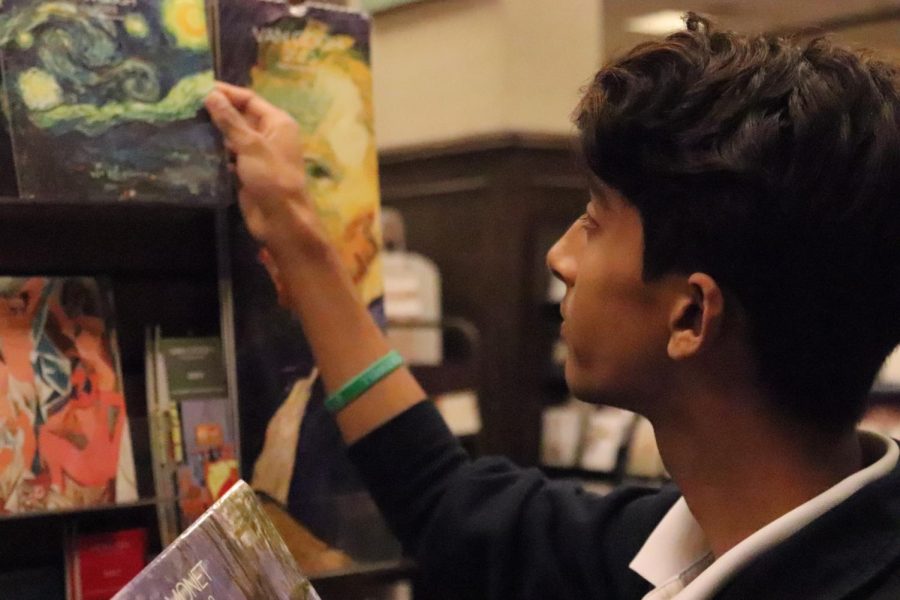Art is more than what meets the eye
Art is often overlooked for its immersive educational and emotional aspects. The Sidekick staff writer Shrayes Gunna details his experience at the Dallas Art Museum to demonstrate how he uses art as a mechanism to flit between worlds and experience new ideas.
October 19, 2022
In spending hours upon hours at the Dallas Museum of Art and walking through its many galleries, I bounce between worlds more rich than the summer breeze or sounds of the city outside. Dipping my toes into French waters through Monet’s “Poplars, Pink Effect” or coming face-to-face with Dallas’s racial history through Bowling’s “Winter Evening,” my perspective is unbound.
And I think that’s substantial: art’s very ability to take the viewer on brief excursions outside of time and space is noteworthy. At the DMA, my view isn’t confined by geographic boundaries, for I may peruse Parisian streets for the sheer pleasure of it or I can examine ancient Chinese brushstrokes to garner a deeper understanding of East Asian history and culture.
Oftentimes, art is dismissed as just a pretty thing to look at, but that discounts the subversive and evocative nature of the medium in the first place. Historically, artists have utilized visual art(painting, drawing, etc.)as a means to record events, offering historians a retrospective look into humanity. Think hieroglyphics.
Not only were these cave drawings, often carved on stone as a linguistic mechanism, but they also capture the religious and historical undergirdings of Ancient Egyptian society. Another instance of art being utilized as a historical measure of recording events is apparent in almost every Texas history textbook, The Surrender of Santa Anna by William Henry Huddle.
Most of us have seen the revered image of Antonio López de Santa Anna perched beneath a tree with a broken leg, but we see the piece as more than a detailed work of art. Students and teachers treat it as a historical artifact—a look into the past—through which they can learn and grasp a new understanding of the Battle of the Alamo. This same methodology ought to be extended to all works of art by looking at them with a meticulous, analytical eye. That’s not to say every work of art is retrospective or a gateway into the past; some are just insight into the emotions, religion or political/social views of the artist, which are just as significant.

These pieces of art, created for the emotional release of it all, are not solely pretty things to decorate your room or intone a museum either. Take Vincent Van Gogh. Each self portrait, still life and landscape he painted transports the viewer to southern France while introducing them to the stylistic norms of the era. While taking a long, absorbent look at “Starry Night” doesn’t reveal some underlying epic about France, it does substantiate the impressionist style that many artists maintained and expose a view of the French countryside inaccessible to many, whether geographically or financially.
Viewers witness culture, cuisine and tradition through the sense of sight; though it’s not as exciting as tasting a baguette in a quaint bakery or smelling French buttercream pervading busy streets, it’s sometimes the only look people can get of foreign destinations. A look all too unappreciated.
These trips to new worlds, cultures and ideas are everywhere, stored within the artwork hung on walls that people glance over and caper pass.
It is not limited to museums. Every scroll on social media, glimmer of a billboard in the car and minute watching/reading the news pertains to a bounty of art in many forms. From photographs to videos detailing the creative process, these stories and flickers of cultures worlds away are present. It just takes a willingness to dive into the position of the creator and take up their perspective, realize their views and empathize with their emotions.
In looking for craftsmanship and storytelling within blankets of paint layered like snow or crisp compositions in a photograph, there’s a trip to take and a welcome invitation. Whether it be aweing at the roof of the Sistine Chapel or smiling at a print of Murakami’s flowers, look deeper than the surface because art isn’t just a pretty thing to look at: it’s reflective of foreign worlds ready to be experienced.
And perhaps, you’ll learn to appreciate art just as much as I did roaming the vast halls of the DMA.
Follow Shrayes (@shrayesgunna) and @ChsCampusNews on Twitter











